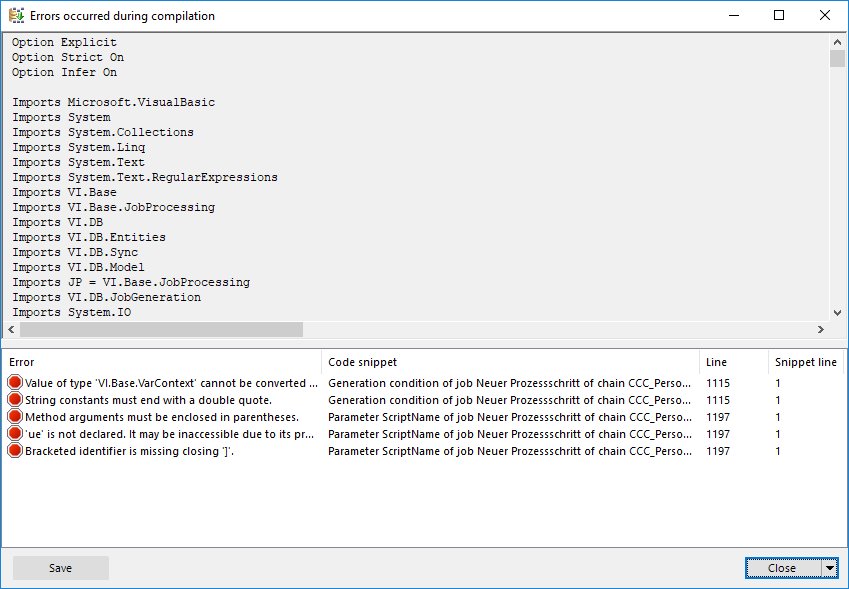Output of errors and warnings during compilation
If compiler errors or warnings occur:
-
Correct the error after compilation is finished.
-
Recompile the database.
Errors are displayed in a separate log window during the compilation process in the Database Compiler.
-
Double-click an error message in the lower part of the log window to jump to the relevant line in the source code view in the upper part of the log window. You can only view the source code you cannot edit it.
-
Select Save to save the error messages to a file.
-
Select Close to close the error log. Then the compilation continues.
Figure 11: Error message log

All compiler errors and warnings are recorded during compilation. You can view compiler errors and warnings after compilation is complete.
To display and save messages
-
Select the Show button to display a message in the error message window. For detailed information about the error message window, see the One Identity Manager Process Monitoring and Troubleshooting Guide.
-
To save all messages to a file, select an entry and then select Save log to file from the context menu.
-
To add a message to the clipboard, select the entry and press Ctrl + C.
Transporting custom changes
Automatic version control is integrated into One Identity Manager, ensuring that One Identity Manager components are always consistent with each other and with the database. If program extensions that change the structure are implemented - for example, table extensions - the database needs to be updated.
You need to update the database if hotfixes and service packs are available for the version of One Identity Manager you are currently running or for complete version updates. In addition, customer-specific changes must be transferred from a development database into the test database and into the production system database.
Detailed information about this topic
Types of transport packages
You can customize the One Identity Manager schema by loading so-called transport packages. One Identity Manager recognizes the following types of transport packages that can be copied to the database depending on requirements.
Table 36: Transport package
|
Migration package |
Migration packages are provided by for the initial database schema installation, for service pack and complete version updates. A migration package contains all the necessary tables, data types, database procedures, and the default One Identity Manager configuration. |
Configuration Wizard |
|
Hotfix package |
Hotfix packages are provided to load individual corrections to the default configuration such as templates, scripts, processes, or files into the database.
NOTE: If a hotfix package only contains changed files, load these files into the database using the Software Loader file. |
Database Transporter
Software Loader |
|
Custom configuration package |
A custom configuration package is used to exchange customer specific changes between the development, test, and productive system database. This transport package is created by the customer and loaded into the database. |
Database Transporter |
NOTE: If, in additional to a hotfix package, there are additional customized configuration settings to be installed in a One Identity Manager database, create a custom configuration package and use the Database Transporter to import it into the target database. There is no support for merging a hotfix package with a custom configuration package into one transport package.
Related topics
Basics for transporting modifications
Different methods are implemented for transporting modifications.
-
Transport of single objects is done through the object layer.
When you import a transport package, the permissions, templates, and customizer in the target database are taken into account.
This method is used, for example, if you use the Database Transporter program to create and import custom configuration packages that contain modifications to a system user, modifications starting from a defined date or to individual objects.
-
The transport of the entire system configuration is done through a transfer buffer.
All relevant tables are checked when creating the transport package. The condition applied to the table, defines which objects are transported. The primary key is used to establish whether the transport entry has a GUID module and whether it is transferred to the source database transfer buffer. The transfer buffer is read and transport package is created. When importing into the target database, the contents of the transport package is transferred to the target database's transfer buffer. The information is then transferred to the target tables.
This method is used if you use the Database Transporter program to create and import custom configuration packages that contain the complete system configuration. This method is also used to install and update the One Identity Manager schema using the Configuration Wizard.
When a transport package is imported into a One Identity Manager database, the following operations are carried out:
-
Inserting objects
If no object was found in the destination database using the primary key or alternative key, a new object is created with this key value.
-
Updating objects
An object found in the target database using the primary key will be updated. The update is done using the configuration buffer.
If transporting modifies a default configuration, the default configuration is moved into the configuration buffer. You can retrieve changes from the configuration buffer and restore the default configuration in this way.
If, during a One Identity Manager version upgrade, the default configuration is changed by a service pack, a complete version upgrade or by loading a hotfix package, a check is made to see if it has already been customized. In this case, the modified default configuration is copied to the configuration buffer. This ensures that customizations do not go missing.
-
Deleting objects
Objects that are no longer needed are deleted. This operation is always run if the entire system configuration is transported.
Related topics

